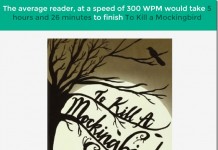 E-books aren’t exactly captivating today’s college students–didn’t Quinn Anya Carey tell you so in the TeleBlog last month, based on the impressions of two representative friends?
E-books aren’t exactly captivating today’s college students–didn’t Quinn Anya Carey tell you so in the TeleBlog last month, based on the impressions of two representative friends?
Now the Associated Press is out with a story somewhat in the same vein, and one of the statements there is especially true. The technology in its present form doesn’t offer enough value compared to paper books. More interactivity and animation and other good stuff would help. Part of the AP story:
Brown University junior Stuart Thompson jumped at the chance to save $30 and become a digital pioneer when his school bookstore offered a discounted, electronic version of an American history textbook.
But after making the purchase, he noticed a few things amiss: He couldn’t run a highlight marker over key points or jot notes in the margins, nor could he curl up with the tome without printing out the pages.
He won’t rule out another e-book, but he’s not completely sold, either.
So much for the belief that this generation of youths is comfortable with everything digital: The publishing industry has been talking about electronic textbooks for a decade already, but sales remain minuscule.
“If you’re reading a 100-page book, staring at the computer that long — I don’t think a lot of people would find that a better way to read,” Thompson said.
OpenReader, anyone? Not only will it allow notes, but it will let teachers and students share them with others. Plus, the DRM is gentler than present alternatives.
Reminder: I’m among the ringleaders of OpenReader.
(AP story found via the eBook Community List.)


































“ ‘If you’re reading a 100-page book, staring at the computer that long — I don’t think a lot of people would find that a better way to read,’ Thompson said. ”
Nor would I. But I could probably read a device with an E-Ink display for quite a long time without the eyestrain or fatigue that results from staring at traditional displays.
Now, if we can get to a sensible and universal format sooner than later so that digital reading devices can make the jump from obscurity into daily use… well, that would be a great improvement, wouldn’t it? Hopefully OpenReader will be among the first (if not the first) to get us there.
Yep, better displays would help. But personally I’d also welcome shared annotations and interbook linking and similar fun. As for E Ink, it isn’t perfect. Different people will have different preferences, but when I tried it, the contrast wasn’t sufficient. Perhaps things have changed since then. – David
This article didn’t mention the detail which probably was the most important–what price were they selling the books for? Cripes, the most recent edition of the history book alluded to in the article was $108 hb (86$ pb).
Holy cow, that’s the cost of an ebookwise! Maybe the student should give ME the money and I can buy 50 used history books on half.com for him/her.
I don’t deny that textbooks add a bit of value, but not THAT much.
Now imagine that the ebook was selling for $10 vs. the paper edition of $100? How many people do you think would buy it? Actually though, a used copy of an earlier 2000 edition sells for $13.
The article mentioned one interesting point: the need to have consistency among editions so students can turn to the right page. If people have several different editions/formats of an ebook, how do they know where exactly to turn? That is a big deal, and something I don’t know that the ereader software companies have adequately addressed.
Actually, textbooks are one case where I’d be more willing to read on a PC than otherwise. Most of the time I was writing a paper or doing work based on the material in the book anyway. Having access to the text on my screen rather than having to look up and down constantly would be very welcome.
I remember learning to program in Pascal for the advanced algorithmics class for Arts and Humanities students (read: dummies) in university. The teachers specifically recommended getting it second-hand, because it was so expensive when new. Difficulties arising from working with different editions were smoothed out easily; after all, in essence this was still the same book, even if we used four or five different editions in the classroom.
Oops, forgot to add that second-hand text books can become third-hand. In essence, you are renting such books. I think I sold my Pascal book for ten bucks less than that I had bought it for, so if the new price was 60 US$, I bought it for 30US$, and sold it for 20 US$, I only paid a fraction of what it originally cost. (Not to mention that the new price may have gone up in the meantime to account for inflation, and that inflation touches students too.)
Anyway, the price of text books is something between students and their teachers. Philip Greenspun once paid MIT students 100 US$ to attend his class, and not because they wouldn’t show up otherwise. He wanted to get the point across that MIT is getting so much money from other sources, they don’t really need to charge tuition fees.
The way money flows through universities can be fascinating to watch, and books could be written about it. Surely teachers, in their zeal to impart their particular brand of wisdom onto pupils, do not need to charge for every transaction. Text books could be gratis.
Now, back to the original story; can you rent e-books? Can you pass them along? If you annotate them, will the annotations be kept during a format shift? Format shifts aren’t necessarily an evil; for one thing, they have helped Project Gutenberg survive longer than almost any other digital book archive.